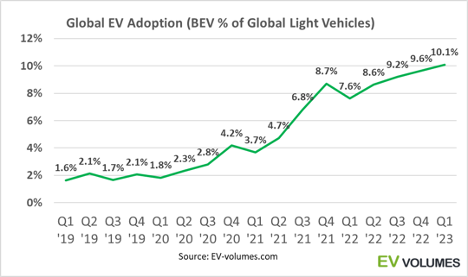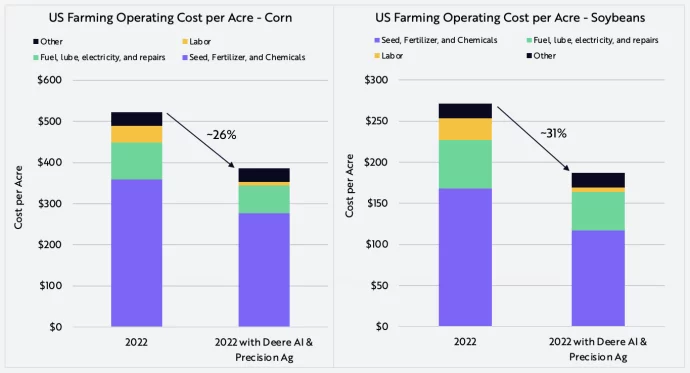#369: The Global Adoption Of Battery Electric Vehicles Is Gaining More Traction, & More
1. The Global Adoption Of Battery Electric Vehicles Is Gaining More Traction

Battery electric vehicle (BEV) sales surpassed 10% share of global light vehicle sales in the first quarter of 2023, as shown below. For the past three years, BEV adoption during the first quarter has lagged that in the fourth quarter, perhaps because of Chinese New Year. This year, however, BEV share broke that seasonal trend.
Not all automakers have participated in the upside. Tesla, BYD, VW, and GAC Motor, for example, accounted for ~75% of the year-to-date BEV sales growth on a year-over-year basis through April 20231—even though they account for only ~48% of total sales—while ~40% of automakers reported BEV sales declines. Macroeconomic headwinds seem to be separating the winners from the losers.

Source: Irle, V. 2023. “Global EV Adoption is on steady increase.” Twitter. Based on data from EV-volumes.com, as of June 2, 2023. https://twitter.com/viktorirle/status/1664633210158850049
2. Falcon 40B Open-Source Large Language Model Can Be Commercialized Thanks To A Permissive Apache 2.0 License
Falcon 40B—an open-source large language model developed in Abu Dhabi—is the latest advance in open-source AI. Notably, the model has surpassed the performance of LLaMA and other open-source models and, with a permissive Apache 2.0 license, can be used for commercial purposes. With FlashAttention and multiquery, the Falcon 40B model architecture has been optimized specifically for inference, which improves processing speeds and overall efficiency. Interestingly, it is outperforming the 65B parameter LLaMA after being trained using less than half the compute (2800PF-days for Falcon vs 6300 PF-days for LLaMA).1
Falcon 40B arrives on the heels of MosaicML’s MPT-7B2 open-source model, which was trained for only $200,000 on the MosaicML platform.3 MPT-7B accommodates inputs up to 84K tokens and matches the performance of Meta’s LLaMA-7B.
We believe open-source large language models will continue to keep pace with commercial counterparts, lowering the costs of building commercial AI applications.
[1] Wolf, T. 2023. “LLaMA is dethroned. A brand new LLM is topping the Open Leaderboard: Falcon 40B.” Twitter. https://twitter.com/Thom_Wolf/status/1662085371826405377.
[2] The MosaicML NLP Team. 2023. “MPT-7B: A new Standard for Open-Source, Commercially Useable LLMs.” MosaicML. Foundation Series. https://www.mosaicml.com/blog/mpt-7b?utm_campaign=Sunday%20Newsletter&utm_medium=email&_hsmi=258348178&_hsenc=p2ANqtz–xSFXiwSo2-zfNBfW8NneOXN6kpHSd7ZWqJmFEcC5mo49mJ5FColgMw1khCRvEX5pKeqc1-ZJ2iqYKlnNrhiktZPY6Pw&utm_content=258348178&utm_source=hs_email.
[3] Compare that to the estimated ~$5 million cost of GPT-3’s final training run in 2020.
3. Deere’s Autonomous And Precision Offerings Could Reduce Farmland Operating Costs By ~25%

Last year, Deere announced1 plans to launch a fully autonomous corn and soybean production system by 2030, beginning with the Autonomous 8R Tractor (the 8R).2 According to our research, when the autonomous technology is combined with its ExactShot Planter3 and See and Spray Ultimate Sprayer,4 operating costs of corn and soybean production are likely to decline by more than 25%.
Autonomous, ExactShot Planter, and See and Spray Ultimate Sprayer should lower several agricultural production costs significantly. First, autonomous removes the need for a farmer to operate the machinery, reducing the labor costs associated with harvesting crops. While the 8R currently focuses on tillage, advances in the technology will automate both the sprayer and the combine. Second, by applying fertilizer directly at the seed level, ExactShot reduces the required amount of starter fertilizer by more than 60%. Finally, See and Spray Ultimate uses computer vision and machine learning to identify and spray weeds in a targeted way, reducing herbicide use by 67-80%.5
Our research shows that Deere’s technology could reduce US corn and soybean farm operating costs by 26% and 31% on a per-acre basis, respectively, as shown below. With a 20-50% take-rate based on the cost savings alone, Deere should be able to generate a recurring revenue stream with software-as-a-service-like margins as its autonomous technology proliferates.

While this analysis has focused on operating costs, ARK also expects autonomous technology to increase machinery utilization rates and, when combined with the gene editing of seeds, to increase crop yields and overall farm productivity dramatically.
[1] Paukner, M. 2022. “Deere: Fully Autonomous Corn, Soybean Production System Planned by 2030.” Precision Farming Dealer. https://www.precisionfarmingdealer.com/articles/5099-deere-fully-autonomous-corn-soybean-production-system-planned-by-2030.
[2] Deere & Company. 2022a. “John Deere Reveals Fully Autonomous Tractor at CES 2022.” John Deere. https://www.deere.com/en/news/all-news/autonomous-tractor-reveal/.
[3] Deere & Company. 2023. “John Deere Debuts New Planting Technology & Electric Excavator During CES 2023 Keynote.” John Deere. https://www.deere.com/en/news/all-news/deere-debuts-new-planting-technology-and-electric-excavator-ces-2023/.
[4] Deere & Company. 2022b. “Deere launches See & Spray™ Ultimate: in-season targeted spray technology combined with a dual product solution system for corn, soybeans, and cotton.” John Deere. https://www.deere.com/en/news/all-news/see-spray-ultimate/.
[5] Scalcup, L. 2022. “Texas Grower Puts John Deere’s See and Spray Technology to the Test.” AgWeb. https://www.agweb.com/news/machinery/new-machinery/texas-grower-puts-john-deeres-see-and-spray-technology-test.


